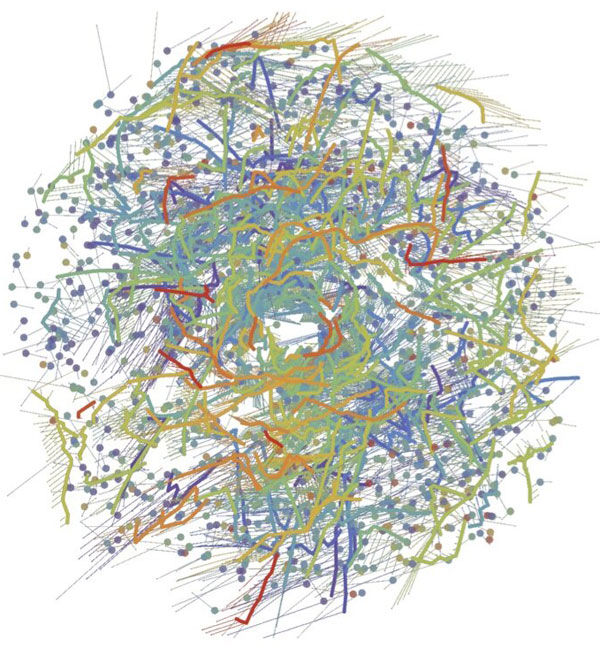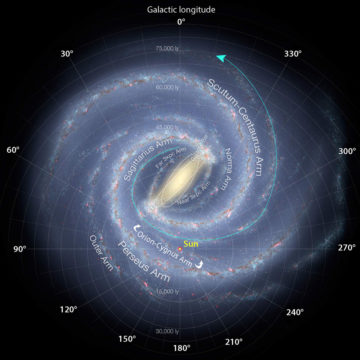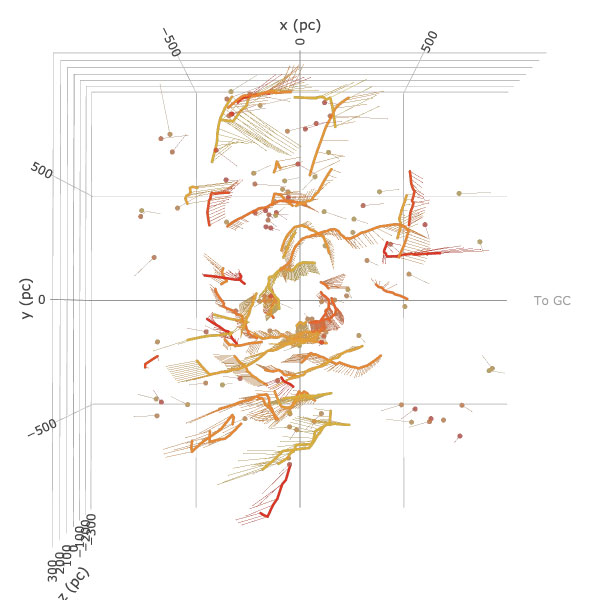Long-lived, string-shaped groups of stars align with the Milky Way’s spiral arms — and they may provide clues to what those arms looked like long ago.
Astronomers have identified thousands of stellar groups within 3,000 light-years of the Sun. But the 3D map they created resembles a tangle of yarn more than it does a field of stars.
That’s because hundreds of the groups they discovered appear to be filamentary, thread-like structures. These threads of stars may trace the evolution of the Milky Ways’ spiral arms, Marina Kounkel (Western Washington University) and colleagues explain in the August 23rd Astronomical Journal.

Courtesy of M. Kounkel & K. Covey (2019)
Machines Pull the Strings
Kounkel and her colleagues started with 20 million stars for which the European Space Agency’s Gaia satellite had measured positions on the sky and distances from Earth, as well as velocities toward or away from Earth. The researchers used a type of artificial intelligence called unsupervised machine learning to sort through the immense amount of data, determining whether and how these stars are clustered.
“Unsupervised machine learning” may sound like trouble, but all it means in this case is that a computer algorithm grouped stars without being told what the groups ought to look like. As a result, the algorithm was able to find groups of all kinds of shapes and sizes — including strings.
Most stars, it appears, are on their own — the algorithm only tagged 1.5% of the 20 million stars as belonging to a group. But of those stars moving through space together, roughly half belong to long, string-shaped groups. The other half divide themselves among more than 1,000 smaller and more spherical groups.
The stellar strings are on average 30 light-years across and 650 light-years long, a length that matches the typical size of a star-forming cloud. Kounkel says it’s likely that a single cloud makes a single string of stars.
What’s more, none of the strings has a central cluster, indicating that they didn’t start out as sphere-shaped groups that the Milky Way’s gravity pulled apart over time. Instead, Kounkel and her colleagues argue these groups been string-shaped from the get-go.
What’s My Age Again?
To explore the evolution of the string-like structures, astronomers need to know how old the stars are. But stars are reluctant to reveal their ages — burning balls of hydrogen gas don’t change much in appearance throughout lifetimes lasting billions of years.
Kounkel and her colleagues turned to machine learning a second time. This time, they trained a neural network on star clusters with known ages before setting it loose on the newly discovered groups. The astronomers then combined these results with more traditional methods to obtain more accurate stellar ages.
You can explore an interactive, 3D map of the groups, separated by age, here.
(Note that the map divides stars by logarithmic age. A star marked as “7.0” in the map has an actual age of 107, or 10 million years.)
Spiral Echoes
The strings are surprisingly long-lived. “We generally thought young stars would leave their birth sites just a few million years after they form, completely losing ties with their original family,” Kounkel explains. “But it seems that stars can stay close to their siblings for as long as a few billion years.”

ESO
At the same time, the strings appear to trace something that’s surprisingly ephemeral: The Milky Way’s spiral arms. Though from afar spiral arms appear to be made of stars, they’re only forming stars — the stars themselves are passing through, the same way cars pass through traffic jams. When gas clouds hit the stop-and-go traffic, they become compressed, collapsing into groups of hundreds or thousands of stars.
The youngest strings — those younger than 100 million years old — together form a narrow structure that aligns with the Local Arm of the Milky Way, the spiral arm that houses the Sun. The strings themselves lie perpendicular to the Local Arm, though it’s still unclear why.

M. Kounkel et al. / Astronomical Journal
Kevin Luhman (Penn State), who was not involved in the study, says he’d expect the collection of strings to align with the Local Arm. “Because of the linear shape of the original arm and its clouds, the resulting stars will also have a linear, string-like configuration for a time,” he explains.
Older strings appear to align in ways that don’t relate to the Local Arm, but Kounkel and her colleagues argue they might mark other spiral arms that have since dissipated. Coauthor Kevin Covey (also at Western Washington University) notes, “Older strings are an important ‘fossil record’ of our galaxy's spiral structure.”
The team plans further studies with Gaia data and comparisons with simulations to better understand how these stellar structures evolve.
 4
4
Comments
Peter Wilson
September 7, 2019 at 9:57 am
Finally! Some String Theory I can understand...
You must be logged in to post a comment.
TorbjornLarsson
September 8, 2019 at 4:11 am
For me, the opposite. String theory is simple in principle, this is a mess (perhaps not in principle, but the article is unclear on arm formation).
You must be logged in to post a comment.
Rod
September 8, 2019 at 8:10 am
*but the article is unclear on arm formation).* This is a good point. Are the Gaia observations showing *short-lived stellar structures* in the galaxy compared to the Hubble time age of the universe, globular cluster ages, and an age for the Milky Way, say about 10-11 billion year old? My thinking is yes. The ability for spiral arms to exist over billions of years vs. short-lived structures (that then must be regenerated) is discussed in some groups but not commonly covered.
You must be logged in to post a comment.
Corey Rueckheim
September 10, 2019 at 12:59 am
It seems that Gaia and AI has opened a "can of worms" here, but we shouldn't really be surprised, should we? The sheer quantity of data provided by Gaia is expected to revolutionize our understanding of the Milky Way (and thus other galaxies as well), and we are just dipping our toes in the ocean of data so far. These "star strings" are just one small piece in the giant puzzle that will only become clearer over time (think decades, if not centuries).
The paragraph that really catches my attention, and is worth repeating is: "What’s more, none of the strings has a central cluster, indicating that they didn’t start out as sphere-shaped groups that the Milky Way’s gravity pulled apart over time. Instead, Kounkel and her colleagues argue these groups been string-shaped from the get-go." This seems to indicate that there is no connection between star clusters and star strings, and implies that there are likely two clearly-defined methods of star formation. The first method would be the gravitational collapse of molecular clouds into spherical clusters. This new data also implies that these clusters must disperse in a way that never mimics the strings (i.e. are not stretched out into strings). In contrast, the second method of star formation must be something that collapses the dust and gas in only two dimensions instead of three (forming the strings as opposed the spheres). It wouldn't surprise me at all if spiral arms are responsible for forming them, or if spiral arm formation and star string formation are caused by the same, or at least closely-related, phenomena (perhaps simply from density waves).
I can't wait to see how this all plays out! And just imagine what we will learn a few decades from now with data from Gaia's successor, and with future evolutions of AI!
You must be logged in to post a comment.
You must be logged in to post a comment.